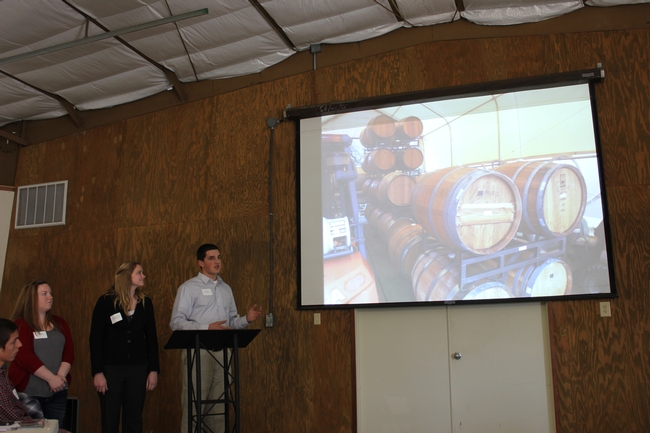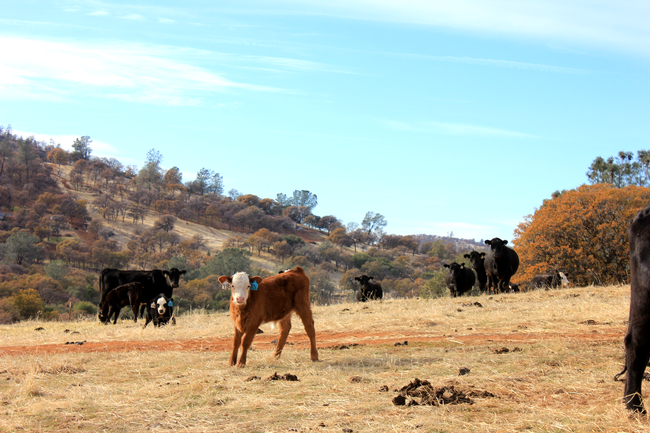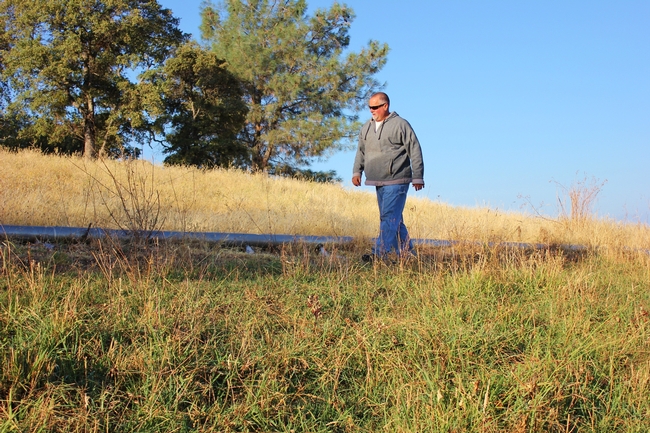- Author: Jeremy James
The annual California Grazing Academy held at UC SFREC and led by Roger Ingram, Nevada/Placer County UCCE Director and Livestock Advisor was once again a widely attended and engaging event. Over a third of an inch of rain cooled off the 24 participants that attended the two-day event that mixed lectures and hand-on activities to explore and demonstrate key principles that drive the ability of producers to be successful grass farmers. Topics included controlled grazing principles, water and mineral cycles, pasture cell design, rest/grazing periods, nutrition and supplementation as well as grazing planning and monitoring. Each participant had the opportunity to visually estimated carrying capacity, install electric fencing, move cows with calves into their designated paddocks, and watch the cattle consume pasture grass over a period of 24 hours. This annual training has remained hugely popular across California and the West with some participants coming as far as Utah to learn from UCCE and Roger Ingram. We looked forward to another year!

- Author: Maddison Easley
This past Saturday, February 22nd, SFREC hosted a forum focused on the future of farming and ranching in the Sierra foothills. 
About sixty members of surrounding communities in Nevada, Placer, Yuba, and Sutter counties made it out to UC SFREC for a day of learning, interaction with professionals, and networking. For the vast majority of the attendees, this was their first introduction to SFREC and the UC Research and Extension Center system.
The speakers offered insightful and useful information that engaged the entire audience. Jamie Johansson, Second Vice President of the California Farm Bureau and owner of Lodestar Farms, kick started the conversations by speaking about the opportunities and challenges of farming in the foothills. Dan Macon, representing Placer County UCCE and Flying Mule Farm, offered logical business planning strategies from a personal and professional perspective. 
A significant aspect of this event focused on incorporating local youth. We were able to help partner students from high schools in the region with a few of the producer-presenters prior to the forum. This additional opportunity enabled a more profound learning experience for students interested in the future of farming and ranching. 
There was a DELICIOUS locally sourced lunch with juicy tri-trip, salads, bread, and lavender sweets. Briar Patch co-op in Grass Valley also donated coffee and pastries for the event. Local ag and natural resource conservation groups brought educational materials to share. Attendees enjoyed the beautiful weather and slowly greening rangeland on a brief tour of the center.
Overall, it was a successful event that kindled connections with the community and opened the door for future cooperative efforts.
- Author: Jeremy James
For ranchers in most parts of the state the 2013-2014 drought is shaping up to be one of the most serious forage situation in memory. As an example, forage data at UC SFREC showed that dryland range at the Center only produced about 40 pounds per acre through fall and the end of December. 
In response to these serious forage conditions, the University of California Sierra Foothill Research and Extension Center, in cooperation with UCCE Advisors, UC Davis faculty and industry partners, are putting the final touches on the January 29th meeting that will discuss practical tools and strategies for reducing drought impacts on ranching enterprises.
Drought management and mitigation is a complex topic and this day-long event takes a comprehensive look at a range of linked issues including making the most of what you have on dryland and irrigated pasture, the economics and nutritional aspects of supplementation, animal health and making culling decisions, tax, NAP and insurance. Registration is close to capacity but will remain open until capacity is reached. For those that cannot attend in person, the program will be broadcast on the web. You can register to attend (here) and see the updated agenda (here).
- Author: Maddison Easley

In a nutshell, SFREC aims to bring together past, present, and future agriculturists and conservationists in the region who have an interest in discussing the opportunities and challenges associated with farming and ranching in this area and where the industry is headed in the coming years. The intended outcomes include:
- A compelling contribution to the existing extension efforts to create connections and interest in agriculture
- A tool to promote and enable the transfer of knowledge and skills from seasoned professionals to those entering and planning a career pathway in farming and ranching
- An enhanced awareness of the role of local agriculture in a broader sense

The involvement of youth is a central component of the forum. Through collaboration with farmers, ranchers, and agency representatives, high-school aged students from adjacent counties will learn and share information about specific topics under the theme of “The Future of Farming and Ranching in the Sierra Foothills”.
“As a retired ag teacher, I have seen the struggle that students experience between simply having the desire to go into farming or ranching, and grasping the realistic details involved with that livelihood. Working with local producers who have the first-hand experience and know-how will be a great learning opportunity for our future agriculturists,” said Karen Henderson, advisory committee member and Live Wire Products representative.
Be on the lookout for more information and marketing flyers for this inaugural event at the Sierra Foothill Research & Extension Center.
- Author: Maddison Easley
Water - the focus of countless issues, headlines, and studies - is arguably a more precious resource than gold. 
Individuals involved with the University of California's Division of Agriculture and Natural Resources are actively evaluating management practices to ensure and develop water-wise irrigation methods. At the Sierra Foothill Research and Extension Center, many research projects have focused on water quality, runoff, and irrigation efficiency. A current project led by Livestock Farm Advisor Larry Forero monitors surface runoff and soil moisture content in flood irrigated pastures at SFREC. 

Gold may be in high demand - with the current value exceeding $1320 per ounce - but once water becomes scarce, it is truly priceless. By taking the initiative to research innovative water management practices and develop a better understanding of sustainable irrigation methods, SFREC and the entire UCANR division are enabling water availability and conservation for the future.




